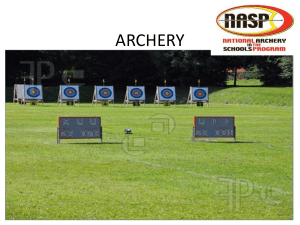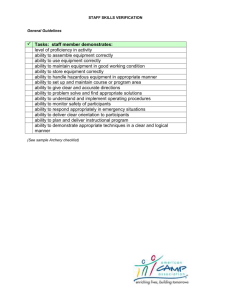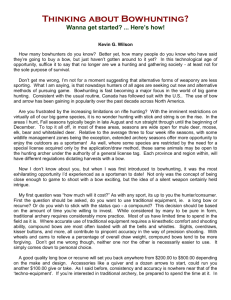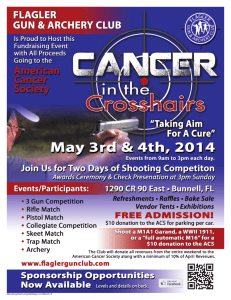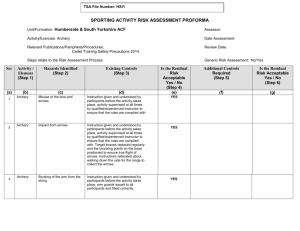Guide to Archery
advertisement
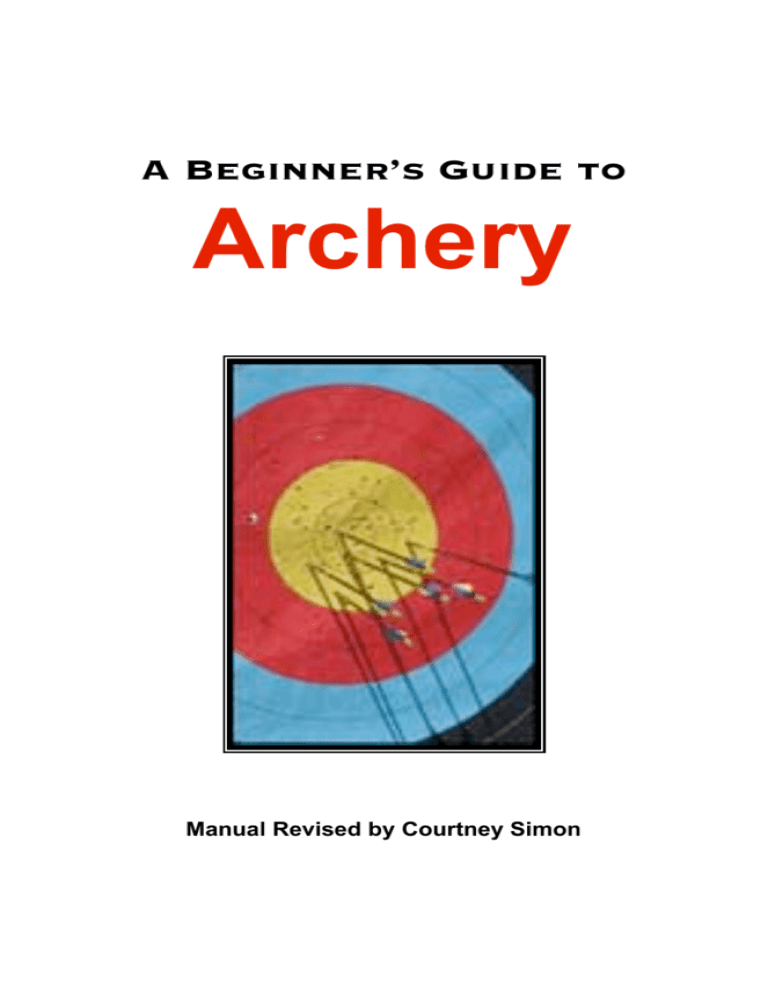
A Beginner’s Guide to Archery Manual Revised by Courtney Simon A Beginner’s Guide to Archery Table of Contents Section One: Choosing Equipment Chapter 1: Recurve Archery 1.1 The Basics of Recurve 1.2 Recurve Diagram Chapter 2: Compound 2.1 The Basics of Compound 2.2 Compound Diagram Chapter 3: Arrows and Other Equipment 3.1 Arrow Diagram 3.2 Bracer, Sight, Stabilizer, Tab, and Quiver 3 4 5 6 7 8 9 Section Two: Getting Started Chapter 4: Technique 4.1 Establishing Stance 4.2 Adjusting Grip 4.3 Marking Finger Position 4.4 Preparing the Shot 4.5 Drawing the bow 4.6 Anchoring 4.7 Aiming 4.8 Loosing 4.9 Following Through Chapter 5: Safety 5.1 Rules 10 Section Three: Competing Chapter 6: Scoring 6.1 Target Diagram Chapter 7: Types of Archery 7.1Target Archery 7.2 Field Archery 22 Section Four: Appendix Chapter 8: Glossary Chapter 9: Acknowledgments 26 27 29 ! "! 11 12 13 14 15 16 17 18 19 20 23 24 25 Section One Choosing Equipment CHAPTER 1: Recurve Archery 1.1 1.2 Introduction Diagram CHAPTER 2: Compound Archery 2.1 2.2 Introduction Diagram CHAPTER 3: Arrows and Other Equipment 3.1 3.2 Arrow Diagram Bracer, Sight, Stabilizer, Tab, and Quiver ! ! ! #! Section One CHAPTER 1: RECURVE ARCHERY 1.1 The Basics of Recurve The recurve bow is the only bow style allowed in the Olympics. The draw weight is slightly heavier than that of a compound bow. The recurve-bow is the most efficient design. The limb tips on a recurve-bow are bent back away from you when in a relaxed position. When the string is drawn back the curves straighten to provide leverage when the string is released and the curves return to their original c-shape. This allows for more arrow speed than a straight limb-bow. The bow’s limb length is fitted for an archer’s size to maximize the leverage provided by the limbs. Modern engineering, sights, stabilizers and carbon arrows make the modern recurve a far superior bow than its traditional predecessors, but there still limits on the types of equipment allowed.!! ! ! ! ! !!!!! ! ! !!!!!!!! !!!!!!!!!!FIGURE 1-A Shooting Recurve http://www.dunkeld-park.co.uk/images/archery.jpg ! $! Section One CHAPTER 1: RECURVE ARCHERY 1.2 Recurve Diagram When selecting a recurve bow, you will need to be measured tor appropriate draw weight, draw length, and hand preference. FIGURE 1-B Recurve Bow Diagram http://www.archery.org.au/scripts/cgiip.exe ! %! Section One CHAPTER 2: COMPOUND ARCHERY 2.1 The Basics of Compound The compound bow has become increasingly popular in the last ten years. The holding weight is dramatically less at full draw. Compound bows are designed with an off-center, pulley or cam mounted on each limb tip. The pulleys are designed and mounted so that the energy needed to pull back the bowstring is the greatest at mid-draw and the smallest at full-draw. This makes the aiming process a lot easier for the archer. When the string is released, this situation is reversed and the speed and energy of the arrow is increased. The compound bow is designed for maximum accuracy. A mechanical trigger, called a release aid, is used to let go of the string and telescopic sights are permitted. Almost anything is allowed provided it is not electronic or electrical.! FIGURE 2-A Shooting Compound http://www.sydneybowman.com/images/ compound 2.jpg ! &! Section One CHAPTER 2: COMPOUND ARCHERY 2.2 Compound Diagram Most of the alterations of a compound bow are in the accessories. Unlike the recurve bow, it will come with the string and cables already attached. FIGURE 2-B Compound Bow http://www.archery.org.au/lib/images/content/ compound%201.jpg ! '! Section One CHAPTER 3: ARROWS AND OTHER EQUIPMENT 3.1 Arrow Diagram There are different types of arrows, but all should have the same parts. There is some variation between indoor and outdoor arrows. FIGURE 3-A Arrow Diagram http://www.royalambassadors.com/sports_activ_ graphic/archery_arrow.jpg ! (! Section One CHAPTER 3: ARROWS AND OTHER EQUIPMENT 3.2 Bracer, Sight, Stabilizer, Tab, and Quiver All of these pieces of equipment are optional; they are used to increase accuracy but may or may not be helpful to all archers. Equipment Labels http://www.merlinarcherycentre.co.uk ! )! Section Two Getting Started CHAPTER 4: Technique 4.1 4.2 4.3 4.4 4.5 4.6 4.7 4.8 4.9 Establishing Stance Adjusting Grip Marking Finger Position Preparing the Shot Drawing the Bow Anchoring Aiming Loosing Following Through CHAPTER 5: Safety 5.1 ! Rules *+! Section Two CHAPTER 4: TECHNIQUE 4.1 Establishing Stance Stance may be different for everyone; practice will determine what is right for you. Read all steps before attempting to establish stance. Stand relaxed, with your feet parallel to the target and slightly apart. Your non-dominant hand and side of your body should be closer to the target. ! ! **! Section Two CHAPTER 4: TECHNIQUE 4.2 Adjusting Grip The more you practice, the more natural it will feel to have a loose grip on the bow. Read all steps before attempting to adjust grip. Keep a relaxed grip on the bow handle with your nondominant hand. You should be able to move your fingers. ! ! ! ! *"! Section Two CHAPTER 4: TECHNIQUE 4.3 Marking Finger Position Keep fingers below the arrow, with enough space to not catch fletching. Read all steps before attempting to mark finger position. Position the string in the first groove of your first three fingers and slide your hand up directly under the arrow until there is no gap. ! ! ! *#! Section Two CHAPTER 4: TECHNIQUE 4.4 Preparing the Shot Be sure your grip and stance are set; do not adjust once the bow is lifted. Read all steps before attempting to prepare the shot. Extend your bow arm and raise it so it is level with the target. Then raise the elbow of your drawing arm so it is level with your shoulder height, or slightly above. Turn your head to look directly at the target. ! *$! Section Two CHAPTER 4: TECHNIQUE 4.5 Drawing the Bow Be sure to keep the arrow pointing straight ahead and your body still. Read all steps before attempting to draw the bow. In a smooth motion, keeping your bow arm level with the target and the elbow of the drawing arm up, draw the bow string back to the side of your face.! ! ! ! *%! Section Two CHAPTER 4: TECHNIQUE 4.6 Anchoring With practice, you will find a comfortable position to anchor your bow. Stay consistent. Read all steps before attempting to anchor. Draw the string fully back to your face so the string is touching your nose and your hand is securely between your neck and ear. You should be able to look directly down the arrow shaft. ! ! *&! Section Two CHAPTER 4: TECHNIQUE 4.7 Aiming A sight may be used to increase accuracy. Take your time and practice finding your target. Read all steps before attempting to aim. If the string is in front of your eye, you should be able to look directly down the arrow to judge your left/right alignment. Focus on the center of the target. ! ! ! *'! Section Two CHAPTER 4: TECHNIQUE 4.8 Loosing Steady your bow before releasing gently. YOU MUST FOLLOW THROUGH (next step). Read all steps before attempting to loose. LET GO!! ! ! *(! Section Two CHAPTER 4: TECHNIQUE 4.9 Following Through This step is critical to shooting accurately. Practice before shooting. Read all steps before attempting to follow through. Your drawing hand should move back slightly, and your head, bow arm and body should hold the same position. Keep focusing on the target. Hold this pose for approximately 2 seconds after the loose.! ! ! ! ! ! ! ! ! ! ! ! *)! Section Two CHAPTER 5: SAFETY 5.1 Rules Rules apply to all types and levels of archery. Failure to follow these rules could lead to serious injury or damaged equipment. 1. Make sure the area you are using the bow in is completely clear, and that no one could accidentally walk within range of your bow. Be aware of arrow deflection should you miss, as it may travel at extreme angles to the target. 2. When drawing the bow, keep it level with the target. Drawing high and then lowering the bow could be very dangerous should a premature release accidentally happen. 3. Inspect your arrows for damage before shooting. If an arrow is damaged, do not shoot it as it may break upon release. FIGURE 5-A Spectator Safety http://www.chateaudubroutel.com/img/archery_instructor ! "+! Section Two CHAPTER 5: SAFETY 5.1 Rules (cont’d) 4. Make sure arrows are long enough so they can not be drawn off the rest and fall inside the bow. 5. When pulling arrows from a target make sure no one is standing behind you. 6. Spectators must always stand behind the archer. 7. Never let anyone draw or shoot your bow if their draw length is longer than yours. Over drawing of the bow can cause damage to the bow. 8. Children must be supervised by an adult at all times! ! ! ! ! !!! ! !! ! ! ! ! ! ! !!!!!!! Child Safety http://www.merlinarcherycentre.co.uk ! "*! Section Three Competing CHAPTER 6: Scoring 6.1 Target Diagram CHAPTER 7: Types of Archery 7.1 7.2 Target Archery Field Archery ! ! ! ! ! ! ! ! ""! Section Three CHAPTER 6: SCORING 6.1 Point System The point system is standard for most types of archery. Note that the points are by circle, not just by color. ! ! FIGURE 6-A Target Points http://www.dsr.wa.gov.au/assets/images/ diagrams/outdoor-archery-target.gif ! "#! Section Three CHAPTER 7: TYPES OF ARCHERY 7.1 Target Archery In target archery, competitors of any ability have the opportunity to participate. It is the most common type of competitive archery. There are quite a number of different target archery rounds, but generally, target archery consists of archers shooting a fixed number of arrows at a specified distance. That target is circular with 10 concentric rings. After an end of arrows, usually 3 or 6, all arrows are scored. At the end of the day, the person with the highest score wins. Target archery is the only form of archery allowed in the olympic games and has over a hundred member nations throughout the world. ! ! ! !!!!!!!!!!!!! ! ! ! !!!!!!!! Target Archery Competition! http://www.merlinarcherycentre.co.uk ! "$! Section Three CHAPTER 7: TYPES OF ARCHERY 7.2 Field Archery Field archery is more closely related with hunting. There are more variables, which make it harder to objectively compete. Field archery takes place in the woods. The distances are unfixed and are determined by the available space and the course-setters ability to set out 14 or 28 targets in safety. The sort of round and distances shot can vary widely. A Hunter and Field round comprise 28 targets each, with four arrows being shot at each target. Other rounds will include shooting at monochrome or colored pictures of animals at marked or unmarked distances. Factors that influence the shot include the lighting conditions, the wide variety of terrain, and the varying distances. It demands high levels of concentration, but with a wider spectrum of skills.!!!! Field Archery http://www.merlinarcherycentre.co.uk ! "%! Section Four APPENDIX CHAPTER 8: Glossary CHAPTER 9: Acknowledgments ! "&! Section Four CHAPTER 8: Glossary This chapter defines commonly used archery terms. These words appear in the manual; page numbers are noted in parenthesis. Arrow Rest (5) The area of the bow above the handle or grip where the arrow sits. Also called Arrow Shelf. Back of Bow (5) The side farthest away from you when you hold bow in shooting position. Brace Height (5) The distance from the string to the deepest part of the handle or grip; this distance can be changed by twisting the string tighter to increase the height and untwisting it to decrease the height. Bracer (9) Material attached to the forearm of the arm that holds the bow to protect it from a string burn or keeps the sleeve from catching on the string. Also called Armguard. Cable Guard (7) The rod on compound bows which keeps the cables away from the center of the bow so the arrow can pass by without hitting the cables. Crest[ing] (8) Bands of color used as decoration or for identification on an arrow near the fletched end. Fletching (8) The feathers or vanes used to stabilize an arrow in flight. Index Feather (8) The feather at right angle to the slit in the nock of the arrow and usually a different color from the remaining feathers. ! "'! Section Four Chapter 8: Glossary [Arrow] Nock (8) The notch at the end of the arrow designed to fit around the bowstring and hold the arrow in place on the string. Quiver (9) A piece of archery equipment that holds arrows. It may be attached to the bow, placed on a belt, or carried on your shoulder or back. Riser (5) The middle part of a bow that has the grip, shelf, sight window and other parts. This part of the bow does not bend when pulling the string. Shaft (8) The body or main section of the arrow. The term "feathered shaft" is frequently used in print to designate an arrow. Sight (9) The aiming device on a compound arrow. Stabilizer (9) A weight rod of various lengths and weights that is attached to a bow to reduce vibrations and supposedly give better control of grouping of shots. Tab (9) A small piece of material placed between fingers and string to protect the fingers while shooting a bow.! ! "(! Section Four CHAPTER 9: Acknowledgments “A Beginner’s Guide to Archery” is based on the Merlin Archery online guide. Listed photos are from various sources. Text and non-listed photos: "Beginner's Guide to Archery." MAC Resource. Merlin Bows, 2007. Web. Nov. 2009 <http://www.merlinarcherycentre.co.uk/ resource/resource_beginners/beg_home.htm>. Glossary Definitions: "Archery Terms and Definitions." Archers-Friend.com. N.p., 2003. Web. 26 Nov. 2009. <http://www.archersfriend.com/archery-terms.html>. Figure 1-A. Shooting Recurve. N.d. N.p., n.d. Web. Nov. 2009. <http://www.dunkeld-park.co.uk/images/archery.jpg>. Figure 1-B. Recurve Bow Diagram. N.d. N.p. n.d. Web. Nov. 2009. <http://www.archery.org.au/scripts/cgiip.exe/ WService=ASP0009/ccms.r?pageid=10214>. Figure 2-A. Shooting Compound. N.d. N.p. n.d. Web. Nov. 2009. <http://www.sydneybowmen.com/images/ Compound2.jpg>. Figure 2-B. Compound Bow Diagram. N.d. N.p. n.d. Web. Nov. 2009. <http://www.archery.org.au/lib/images/content/ compound%201.jpg>. ! ! ")! Section Four Chapter 9: Acknowledgments Figure 3-A. Arrow Diagram. N.d. N.p. n.d. Web. Nov. 2009. <http://www.royalambassadors.com/sports_activ_graphic/ archery_Arrow.jpg>. Figure 5-A. Spectator Safety. N.d. N.p. n.d. Web. Nov. 2009. <http://www.chateaudubroutel.com/img/archery_instructor. jpg>. Figure 6-A. Target Points. N.d. N.p. n.d. Web. Nov. 2009. <http://www.dsr.wa.gov.au/assets/images/Diagrams/Outd oor-archery-target.gif>. ! #+!
